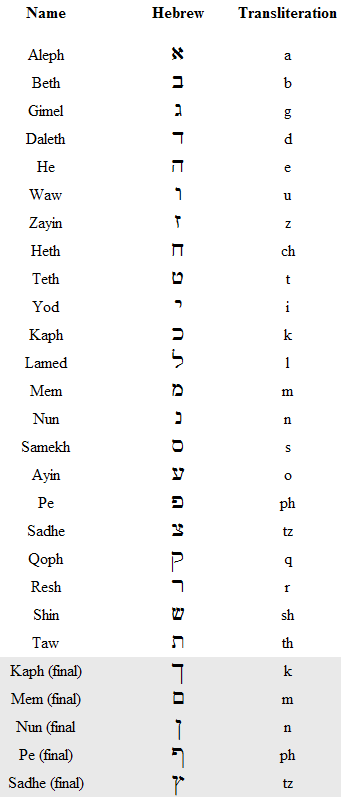THE HEBREW OLD TESTAMENT
The ISA program uses as its
Hebrew text the WLC Westminster Leningrad Codex, which
reproduces the Leningrad Codex B 19a (L), considered the oldest dated manuscript
of the complete Hebrew Bible.
Much of the Old Testament is in Hebrew, but
a few passages (Ezra 4:8 - 6:18, 7:12-26, Jeremiah 10:11, and Daniel 2:4 - 7:28)
are in Chaldee, a close cognate language. In the ISA program, words in Aramaic
(Chaldee) passages are tagged with an (A).
The language
Hebrew is a member of the Semitic family
of languages. Biblical Hebrew is the name used for the Hebrew of the Old Testament.
The reader should bear in mind that the pronunciation of Hebrew in the time
of the writing of the Old Testament books differs from that in the time of the
Masoretic punctuation. The vocalization of the Hebrew Bible represents the pronunciation
as of about the 7th cent. A.D. Much of the discussion about the pronunciation
of the Hebrew text is often hypothetical.
Strictly speaking the sounds of
a language can only be studied in the spoken form. But in dealing with ancient
languages, we have access only to written forms. When the orthography of a language
is not readily recognized by an unfamiliar reader, a system of transliteration
is generally employed. Such a system is neither phonemic nor phonetic, but rather
deals with identification.
The Hebrew letters have been preserved for us in
acrostics, so that we know that there are twenty-two characters in the order as
given in these literary forms (cf. Ps. 34, 111, 112, 119, and 145; Prov. 31-11-31;
Lam. 1,2,3 and 4). The ISA program uses in transcription Latin letters for each
Hebrew letter.
The following course has been proceeded :

The Hebrew text
The orthography
used in the Hebrew text includes not only the alphabet but also the vowel points,
other pointing, the accents, and the sentence indication. The writing of this alphabet was from right to left.
The 'square letters' of our Hebrew Bible, according to Jewish and Christian
tradition, were introduced in the time of Ezra (5th cent. B.C.). At
some point after adopting the Aramaic writing, different forms were developed
for five of the consonants (k,m,n,ph,tz), depending on whether they stood in final
position (word-end) or nonfinal.
As Hebrew became more and more a dead language,
the reading of the text became increasingly difficult. The traditional pronunciation
was preserved by the Masoretes (c. 500-1000 A.D.) who added marks to the 'consonantal
text' to indicate the vowels.
At
certain places the Masoretes preserved a tradition that differed from the 'consonantal
text'.
Since the 'consonantal text' was considered sacred and inviolable,
the Masoretes added the traditional reading in the margin, and placed the vowels
of the traditional reading, together with a mark calling attention to the note,
on the 'consonantal text'.
The 'consonantal text' is called 'kethib', 'written'.
The Masoretic addition of vowel points and marginal letters is called 'qri' or
'qere'.
Some common words are always read according to the 'qere' which is
not placed in the margin. This phenomenon is referred to as a 'perpetual qere'.
The
most common examples of perpetual qere are :
(1) יהוה
[ieue], ('Yahweh'), the proper name of God) is pointed either with the vowels
of אדני
[adni], ('Lord'), or pointed with the vowels of אלהים
[aleim], ('Elohim'), and is to be pronounced as the word whose vowels it borrows.
(2) הוא
[eua], occurs throughout the Pentateuch in place of
היא [eia], the normal spelling of the third person, feminine,
singular pronoun ('she'). There is no clear explanation for this.
With the exception of 'perpetual qere', all Kethib-Qere variants are noted in the ISA program and have been accordingly translated.
related subjects: